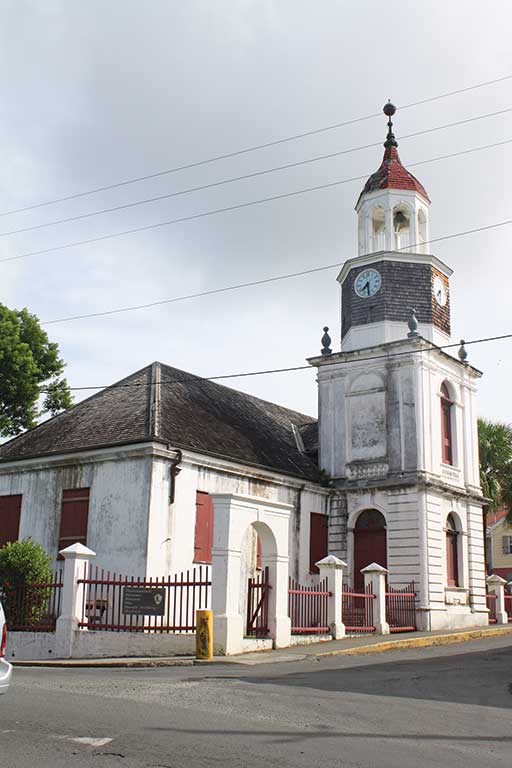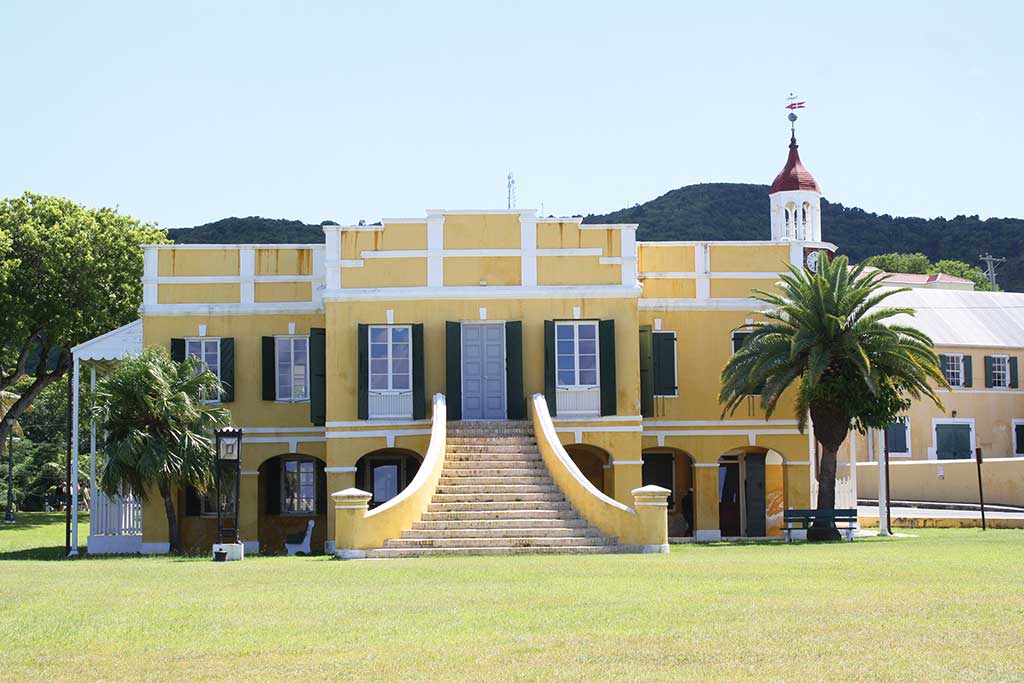Comprising five historic structures dating to the earliest days of Danish colonization, Christiansted National Historic Site (340/773-1460, 8am-5pm daily, adults $3, children under 16 free) is the natural starting point for any exploration of historic Christiansted. On the waterfront and surrounded by expansive lawns, the historic site is immediately identifiable by the yellow color of the fort and other buildings. The stunning contrast between the yellow buildings, blue water, and green grass is reason enough to come. Indeed, the benches scattered around the lawns are an excellent place to pass a few minutes with a book, in conversation, or simply enjoying the view. Explore inside the buildings to delve into their history, beginning with the fort.
The fort was completed in 1749, with significant additions made between 1835 and 1841. After 1878, when laborers rioted throughout the island, the fort was converted into a police station and courthouse. The National Park Service has restored the fort to its 1830s appearance.
The tour of the fort is self-guided, although park rangers are around if you have any questions. Some rooms have been furnished with period furniture to depict the lifestyle of the Danish soldiers and officers. There is also an arsenal stocked with small arms and equipment for the fort’s cannons, and a few boards detail the fort’s construction and the life of St. Croix native Alexander Hamilton. The tour also takes you to the underground cells, where slaves and convicts were punished, and to the fort’s latrines, which emptied right into the sea. The views of Protestant Cay and the Christiansted waterfront from the upper deck are reason enough to come.
The attractive white Steeple Building (corner of Company and Hospital Streets) was the first Danish Lutheran Church on St. Croix. Construction began in 1750, and the building was consecrated in May 1753 as the Church of the Lord of Sabaoth. The distinctive tower, with its four-tiered octagonal cupola, was added 40 years later. Pay attention to the large spans of tray ceilings, restored in 2004 but largely intact from the building’s 1750s construction.

The attractive white Steeple Building was the first Danish Lutheran Church on St. Croix. Photo © Susanna Henighan Potter.
Lutheranism was the official religion of the Danish, so church attendance by military officers, government officials, and members of Danish colonial society was considered mandatory. During the time the Steeple Building functioned as a church, there were two Sunday services. The first, at 9am was conducted in Danish for the European congregation. The second, at noon, was conducted in Creole for nonwhites.
In 1831 the congregation moved to a new church building at the corner of King and Queen Cross Streets, where it remains today. Many of the original church furnishings are still in use at the present-day church. The Steeple Building was then used variously as a warehouse, hospital, bakery, and school before becoming part of the National Historic Site.
Visitors can view a life-size mural depicting the way the building would have been laid out during a church service. There are also a few small exhibits, and National Park Service staff and volunteers may be present to answer your questions.
From 1733, when the Danes bought St. Croix, until 1754, the island was administered by the Danish West India and Guinea Company, a royally chartered slave-trading company that also sold land, traded in sugar and rum, and generally ran every business on the island. The Danish West India and Guinea Company Warehouse (1749), located across Company Street from the Steeple Building, was the administrative and commercial headquarters of the company.
During the second half of the 18th century, the warehouse complex was about three times its present size, containing customs offices, warehouses, and quarters for company staff and slaves. The open yard in the center of the warehouse was used for slave auctions, and historians estimate that 40,000 Africans were sold here during the island’s slavery era. It is the only historic slave market under U.S. government protection, having been purchased by the park service in 2001. Today the warehouse contains offices and public restrooms.
The two-story Scale House, steps from the waterfront, is where hogsheads of sugar and puncheons of rum were weighed for the purposes of taxation before being loaded on ships to Europe and North America. Imports were also carefully measured, logged, and taxed here. The building you see today was built in 1856 and replaced a wooden weighing house first built in 1740.
A scale dating from 1861 is on display on the ground floor, which also houses a National Park Service gift shop and information desk.
The taxes levied at the Scale House were paid at the Customs House next door, a colonial-style building with a wide, sweeping staircase facing the sea. It is perhaps the loveliest of all the buildings in Christiansted. Part of the first floor dates to 1751, when it was part of a row of buildings in the Danish West India and Guinea Company’s warehouse. The existing structure was completed in 1841. The Customs House was the site of the town’s post office until 1927 and then housed the public library until 1972, when it became a part of the historic site. It is not open to the public.

The Customs House dates back to 1751. Photo © Susanna Henighan Potter.
The imposing U-shaped Government House (7-8 King St.), still functions as the governor’s living quarters and office when he is on St. Croix and houses numerous government offices. Government House is not part of Christiansted National Historic Site, but it is still a nice place to visit. Governor-General Peter von Scholten combined two large town houses—the Schopen and Sobotker houses—and added the eastern facade in 1830 to create the building as it appears today. A small red sentry box at the foot of the entrance staircase is an authentic Danish guardhouse.
As long as no official function is going on, visitors are welcome to tour the building, walking around the interior garden and visiting the elegant ballroom on the second floor, where you can see reproductions of original Danish furnishings and fixtures as well as paintings of King Frederik VII of Denmark and Peter von Scholten. Admission is free.
Excerpted from the Sixth Edition of Moon U.S. & British Virgin Islands.